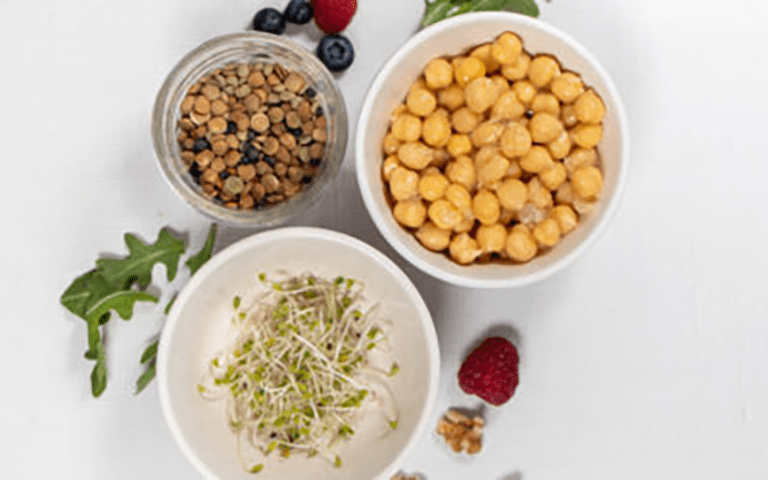How I Eat 30g of Fiber Each Day to Improve Constipation and Bloating
Hands up for Fiber 🙌
Ladies, I know you are busy and just thinking about adding one more thing to your meals sounds complicated But adding fiber to your meals doesn’t have to be!
Improving your fiber intake can be an easy solution! 👏
Fiber is an important component for overall gut health, and studies show that most americans get only 50% of their daily recommended fiber.
Note: There are different kinds of fiber. There’s soluble fiber, like pectin. Soluble fiber coats your GI tract, helping it function properly, and you’ll feel more satisfied after eating.
There also is insoluble fiber, which coats the walls of your intestine, helping to keep it strong (even if it doesn’t move through easily). Both make you feel full.
Quick tip: You can also try drinking more water! It’s important to stay hydrated throughout the day so that you don’t feel bloated either from eating too much fiber or not drinking enough water (which could cause constipation).
Here are some ideas for how to increase your fiber intake at each meal of the day
Breakfast
Breakfast is an important meal of the day. It’s not only a chance to fuel your body with energy, but also give you that much-needed boost of serotonin to get you ready for the day.
Fiber at breakfast will help keep your blood sugar stable, keep you full for hours AND prevent that dreaded 2pm crash.
The easiest fiber additions to your breakfast:
-Chia seeds to your oatmeal (make sure to add protein and fat too!)
-Flax seeds in your smoothie
-Seeds/nuts into your yogurt parfait
If you are choosing grains at breakfast, choose whole grains like oatmeal and whole grain toast to pack some extra fiber and be sure to pair these sources with plenty of protein and fat to keep your blood sugar stable throughout the morning. The motto here: no lonely carbs!
My favorite fiber-rich breakfast:
Chia seed pudding with collagen protein + fresh berries + pumpkin seeds (11 grams)
The best part? This meal takes less than 5 minutes to make and can be made in advance. Plus, it contains: protein, fat, fiber and color–all of the essential meal time components!
Lunch
Lunch is the perfect time to add more fiber to your diet to keep you full and stable throughout the afternoon
Fiber can be found in many of the foods we eat, but if you want to get more of it in your menu, try adding these 5 options:
- Add fruits and veggies to your salad (or other lunch dishes) for extra fiber.
- Add nuts and seeds on top of salads – they provide healthy fats as well as protein so you won’t feel hungry as fast!
- Add a veggie side to your sandwich. Raw carrots/celery + your favorite dip is a great way to get some added fiber + add some crunch!
My favorite fiber-rich lunch:
Chicken, sweet potatoes, asparagus, and avocado (8 grams)
Again, the best part of this meal is that it contains all of the essential meal time components + is usually leftovers from the night before and requires minimal prep!
Snacks
Snacks should be high in fiber and protein. Here are some examples:
- A handful of nuts (7 grams fiber) with a piece of cheese (4 grams protein)
- A bowl of oatmeal (7 grams fiber) with an egg (5 grams protein)
- A handful of trail mix (6 grams fiber), apple slices (2 grams fiber), yogurt (8 grams protein)
My favorite fiber-rich snack:
Pumpkin seed butter + fruit (6 grams)
Dinner
Just as the main protein in our diet are meats, we also want to incorporate more pulses like beans, lentils, or chickpeas, and tons of vegetables to increase our fiber intake. If your gut doesn’t tolerate beans and pulses yet, give yourself time and go slow. Introducing slowly is the key to tolerating foods over time.
My favorite fiber-rich dinner:
Quinoa taco salad – quinoa, ground beef, peppers, onions, beans, tomatoes, cilantro + lime vinaigrette (5 grams)
The best way to add more fiber to your diet?
Create simple mealtime fiber additions like the ones listed above. Fueling your gut doesn’t have to be centered around cutting things out. Its more about abundance and thinking about what you can add.
Now remember – a sudden increase in fiber intake can cause digestive discomfort, so start with small amounts and gradually increase over time. Give your body time to adjust and listen to its signals. Remember, a healthy gut is key to overall wellness
So if you find that you are not tolerating fiber well, it’s important to remember that it should be introduced slowly and methodically – think 2-3 grams at a time until you reach your goal amount. And not tolerating fiber could be a sign of a deeper gut issue (like an imbalance of bacteria!)
Fun Fact: Your gut bacteria digest fiber FOR you….so if you lack beneficial bacteria in your gut, you will have a harder time tolerating it!
Lastly, when thinking about incorporating more fiber to support your gut…
- Don’t be afraid to try new foods.
- Don’t be afraid to experiment with different flavors.
- Don’t be afraid to try new recipes.
- Don’t be afraid to try new cooking methods.
- Don’t be afraid to try new ingredients, especially if you don’t like a particular ingredient or food at first, but then grow to love it as a part of your diet!









